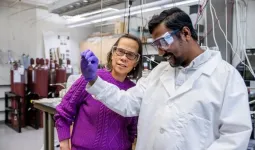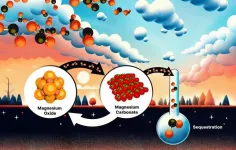(Press-News.org) Viruses have limited genetic material—and few proteins—so all the pieces must work extra hard. Zika is a great example; the virus only produces 10 proteins. Now, in a study published in the journal PLOS Pathogens, researchers at Sanford Burnham Prebys have shown how the virus does so much with so little and may have identified a therapeutic vulnerability.
In the study, the research team showed that Zika’s enzyme—NS2B-NS3—is a multipurpose tool with two essential functions: breaking up proteins (a protease) and dividing its own double-stranded RNA into single strands (a helicase).
“We found that Zika’s enzyme complex changes function based on how it’s shaped,” says Alexey Terskikh, Ph.D., associate professor at Sanford Burnham Prebys and senior author of the paper. “When in the closed conformation, it acts as a classic protease. But then it cycles between open and super-open conformations, which allows it to grab and then release a single strand of RNA—and these functions are essential for viral replication.”
Zika is an RNA virus that’s part of a family of deadly pathogens called flaviviruses, which include West Nile, dengue fever, yellow fever, Japanese encephalitis and others. The virus is transmitted by mosquitoes and infects uterine and placental cells (among other cell types), making it particularly dangerous for pregnant women. Once inside host cells, the virus re-engineers them to produce more Zika.
Understanding Zika on the molecular level could have an enormous payoff: a therapeutic target. It would be difficult to create safe drugs that target the domains of the enzyme needed for protease or helicase functions, as human cells have many similar molecules. However, a drug that blocks Zika’s conformational changes could be effective. If the complex can’t shape-shift, it can’t perform its critical functions, and no new Zika particles would be produced.
An efficient machine
Researchers have long known that Zika’s essential enzyme was composed of two units: NS2B-NS3pro and NS3hel. NS2B-NS3pro carries out protease functions, cutting long polypeptides into Zika proteins. However, NS2B-NS3pro’s abilities to bind single-stranded RNA and help separate the double-stranded RNA during viral replication were only recently discovered.
In this study, the researchers leaned on recent crystal structures and used protein biochemistry, fluorescence polarization and computer modeling to dissect NS2B-NS3pro’s life cycle. NS3pro is connected to NS3hel (the helicase) by a short amino acid linker and becomes active when the complex is in its closed conformation, like a closed accordion. The RNA binding happens when the complex is open, whereas the complex must transition through the super-open conformation to release RNA.
These conformational changes are driven by the dynamics of NS3hel activity, which extends the linker and eventually “yanks” the NS3pro to release RNA. NS3pro is anchored to the inside of the host cell’s endoplasmic reticulum (ER)—a key organelle that helps shepherd cellular proteins to their appropriate destinations—via NS2B and, while in the closed conformation, cuts up the Zika polypeptide, helping generate all viral proteins.
On the other side of the linker, NS3hel separates Zika’s double-stranded RNA and conveniently hands a strand over to NS3pro, which has positively charged “forks” to grab on to the negatively charged RNA.
“There’s a very nice groove of positive charges,” says Terskikh. “So, RNA just naturally follows that groove. Then the complex shifts to the closed conformation and releases the RNA.”
As NS3hel reaches forward to grab the double-stranded RNA, it pulls the complex with it; however, since the NS3pro is anchored in the ER membrane, and the linker can only extend so far, the complex snaps into the super-open conformation and releases RNA. The complex then relaxes back to the open conformation, ready for a new cycle.
Meanwhile, when NS3pro detects a viral polypeptide to cut, it forces the complex into the closed conformation, becoming a protease. The authors call this process “reverse inchworm,” because grabbing and releasing the single-stranded RNA resembles inchworm movements, but backward, with the jaws (the protease) trailing behind.
In addition to providing a possible therapeutic target for Zika, this detailed understanding could be applied to other flaviviruses, which share similar molecular machinery.
“Versions of the NS2B-NS3pro complex are found throughout the flaviviruses,” says Terskikh. “It could potentially constitute a whole new class of drug targets for multiple viruses.”
END
Study reveals Zika’s shape-shifting machinery—and a possible vulnerability
Zika’s crucial enzyme performs multiple tasks, but a wrench in the system could bring it to a screeching halt
2023-12-08
ELSE PRESS RELEASES FROM THIS DATE:
RIT leading STEM co-mentoring network
2023-12-08
Two Rochester Institute of Technology professors are leading a National Science Foundation-funded project to support minoritized women students in STEM through a co-mentoring network called WiSEN (Women in STEM Network).
Betsy Dell, professor in the College of Engineering Technology, and Makini Beck, assistant professor in the College of Liberal Arts and the School of Individualized Study, have teamed up with Washington State University, Gonzaga University, and the University of Montana to use nearly $600,000 awarded by the NSF to create a network model to connect women STEM students. Sarah Bark was recently hired to be the project manager. She will support the daily operations and ensure ...
Genetic mutations that promote reproduction tend to shorten human lifespan, study shows
2023-12-08
A University of Michigan-led study based on a review of genetic and health information from more than 276,000 people finds strong support for a decades-old evolutionary theory that sought to explain aging and senescence.
In 1957, evolutionary biologist George Williams proposed that genetic mutations that contribute to aging could be favored by natural selection if they are advantageous early in life in promoting earlier reproduction or the production of more offspring. Williams was an assistant professor at Michigan State University at ...
CAMH develops potential new drug treatment for multiple sclerosis
2023-12-08
December 8, 2023 (Toronto) – CAMH-led pre-clinical studies using a small molecule drug have shown promise as a potential new treatment for multiple sclerosis (MS). The results have been published today in the journal Science Advances.
Expanding on Dr. Fang Liu’s earlier work that identified a novel drug target for the treatment of MS, she and her team have now created a small molecule compound that is effective in two different animal models of MS. This represents a key advancement that brings this MS research closer to the clinic to impact patient care.
MS is a progressive neurological ...
Polyethylene waste could be a thing of the past
2023-12-08
An international team of experts undertaking fundamental research has developed a way of using polyethylene waste (PE) as a feedstock and converted it into valuable chemicals, via light-driven photocatalysis.
The University of Adelaide’s Professor Shizhang Qiao, Chair of Nanotechnology, and Director, Centre for Materials in Energy and Catalysis, at the School of Chemical Engineering, led the team which published their findings in the journal Science Advances.
“We have upcycled polyethylene plastic waste into ethylene and propionic acid with high selectivity using atomically dispersed metal catalysts,” said Professor Qiao.
“An oxidation-coupled ...
A dynamic picture of how we respond to high or low oxygen levels
2023-12-08
SAN FRANCISCO—December 8, 2023—It only takes holding your breath for slightly too long to understand that too little oxygen is bad for you. But can you also have too much? Indeed, breathing air with a higher oxygen level than your body needs can cause health problems or even death.
But with scant research on the topic, scientists have known little about how the body senses too much oxygen. Now, a new study from Gladstone Institutes has greatly expanded the scientific body of knowledge about the mechanisms at play, and why it matters for health.
Their findings, reported in the journal Science Advances, explain how breathing air with different levels of ...
University of Toronto researchers discover new lipid nanoparticle that shows muscle-specific mRNA delivery, reduces off-target effects.
2023-12-08
TORONTO – A team of researchers based at the University of Toronto’s (U of T) Leslie Dan Faculty of Pharmacy has discovered a novel ionizable lipid nanoparticle that enables muscle-focused mRNA delivery while minimizing off-target delivery to other tissues. The team also showed that mRNA delivered by the lipid nanoparticles investigated in their study triggered potent cellular-level immune responses as a proof-of-concept melanoma cancer vaccine.
The study, led by Bowen Li, assistant professor, Leslie Dan Faculty of Pharmacy, U ...
Evolving insights in blood-based liquid biopsies for prostate cancer interrogation
2023-12-08
“In the United States, 288,300 new cases of prostate cancer are estimated for 2023 [...]”
BUFFALO, NY- December 8, 2023 – A new research perspective was published in Oncoscience (Volume 10) on November 30, 2023, entitled, “Evolving insights in blood-based liquid biopsies for prostate cancer interrogation.”
During the last decade, blood sampling of cancer patients aimed at analyzing the presence of cells, membrane-bound vesicles, or molecules released by primary tumors or metastatic growths emerged as an alternative to traditional tissue biopsies. The advent of this minimally invasive approach, known as blood-based liquid biopsy, ...
Finding the most heat-resistant substances ever made
2023-12-08
The most durable, heat-resistant materials ever made could be hiding in plain sight.
The U.S. Department of Defense wants to know if minerals and rocks found on Earth and in space hold the secrets of next-generation high-temperature materials. To find out, the DOD awarded $6.25 million through its Multidisciplinary University Research Initiative, or MURI, to a team from the University of Virginia and Arizona State University. The group is led by UVA’s Elizabeth J. Opila, the Rolls-Royce Commonwealth Professor and chair of the Department of Materials Science and Engineering.
The ...
Time-tested magnesium oxide: Unveiling CO2 absorption dynamics
2023-12-08
Magnesium oxide is a promising material for capturing carbon dioxide directly from the atmosphere and injecting it deep underground to limit the effects of climate change. But making the method economical will require discovering the speed at which carbon dioxide is absorbed and how environmental conditions affect the chemical reactions involved.
Scientists at the Department of Energy’s Oak Ridge National Laboratory analyzed a set of magnesium oxide crystal samples exposed to the atmosphere for decades, and another for days to months, to gauge the reaction rates. They found that carbon ...
Engaging heterosexual men more effectively could slash HIV infections in Uganda
2023-12-08
A study looking at 15 years of HIV transmission and suppression in Uganda reveals how closing gender gaps in treatment could slash infection rates.
Providing more heterosexual men with easy access to HIV treatment and care could help to suppress the virus and rapidly cut transmission to their female partners, shows a new study published in Nature Microbiology.
The research, led by scientists from Imperial College London and the Rakai Health Sciences Program in Uganda, analysed 15 years of data from 2003-2018, during which the US President’s Emergency Plan For AIDS ...
LAST 30 PRESS RELEASES:
Interaction of climate change and human activity and its impact on plant diversity in Qinghai-Tibet plateau
From addressing uncertainty to national strategy: an interpretation of Professor Lim Siong Guan’s views
Clinical trials on AI language model use in digestive healthcare
Scientists improve robotic visual–inertial trajectory localization accuracy using cross-modal interaction and selection techniques
Correlation between cancer cachexia and immune-related adverse events in HCC
Human adipose tissue: a new source for functional organoids
Metro lines double as freight highways during off-peak hours, Beijing study shows
Biomedical functions and applications of nanomaterials in tumor diagnosis and treatment: perspectives from ophthalmic oncology
3D imaging unveils how passivation improves perovskite solar cell performance
Enriching framework Al sites in 8-membered rings of Cu-SSZ-39 zeolite to enhance low-temperature ammonia selective catalytic reduction performance
AI-powered RNA drug development: a new frontier in therapeutics
Decoupling the HOR enhancement on PtRu: Dynamically matching interfacial water to reaction coordinates
Sulfur isn’t poisonous when it synergistically acts with phosphine in olefins hydroformylation
URI researchers uncover molecular mechanisms behind speciation in corals
Chitin based carbon aerogel offers a cleaner way to store thermal energy
Tracing hidden sources of nitrate pollution in rapidly changing rural urban landscapes
Viruses on plastic pollution may quietly accelerate the spread of antibiotic resistance
Three UH Rainbow Babies & Children’s faculty elected to prestigious American Pediatric Society
Tunnel resilience models unveiled to aid post-earthquake recovery
Satellite communication systems: the future of 5G/6G connectivity
Space computing power networks: a new frontier for satellite technologies
Experiments advance potential of protein that makes hydrogen sulfide as a therapeutic target for Alzheimer’s disease
Examining private equity’s role in fertility care
Current Molecular Pharmacology achieves a landmark: real-time CiteScore advances to 7.2
Skeletal muscle epigenetic clocks developed using postmortem tissue from an Asian population
Estimating unemployment rates with social media data
Climate policies can backfire by eroding “green” values, study finds
Too much screen time too soon? A*STAR study links infant screen exposure to brain changes and teen anxiety
Global psychiatry mourns Professor Dan Stein, visionary who transformed mental health science across Africa and beyond
KIST develops eco-friendly palladium recovery technology to safeguard resource security
[Press-News.org] Study reveals Zika’s shape-shifting machinery—and a possible vulnerabilityZika’s crucial enzyme performs multiple tasks, but a wrench in the system could bring it to a screeching halt






